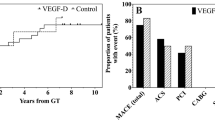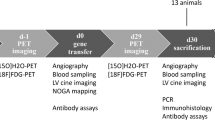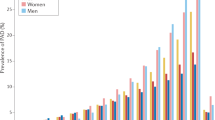Abstract
Peripheral artery disease is a progressive disease. Primary ischemic leg symptoms are muscle fatigue, discomfort or pain during ambulation, known as intermittent claudication. The most severe manifestation of peripheral artery disease is critical limb ischemia (CLI). The long-term safety of gene therapy in peripheral artery disease remains unclear. This four center peripheral artery disease registry was designed to evaluate the long-term safety of the intramuscular non-viral fibroblast growth factor-1 (NV1FGF), a plasmid-based angiogenic gene for local expression of fibroblast growth factor-1 versus placebo in patients with peripheral artery disease who had been included in five different phase I and II trials. Here we report a 3-year follow-up in patients suffering from CLI or intermittent claudication. There were 93 evaluable patients, 72 of them in Fontaine stage IV (47 NV1FGF versus 25 placebo) and 21 patients in Fontaine stage IIb peripheral artery disease (15 NV1FGF versus 6 placebo). Safety parameters included rates of non-fatal myocardial infarction (MI), stroke, death, cancer, retinopathy and renal dysfunction. At 3 years, in 93 patients included this registry, there was no increase in retinopathy or renal dysfunction associated with delivery of this angiogenic factor. There was also no difference in the number of strokes, MI or deaths, respectively, for NV1FGF versus placebo. In the CLI group, new cancer occurred in two patients in the NV1FGF group. Conclusions that can be drawn from this relatively small patient group are limited because of the number of patients followed and can only be restricted to safety. Yet, data presented may be valuable concerning rates in cancer, retinopathy, MI or strokes following angiogenesis gene therapy in the absence of any long-term data in angiogenesis gene therapy. It may take several years until data from larger patient populations will become available.
This is a preview of subscription content, access via your institution
Access options
Subscribe to this journal
Receive 12 print issues and online access
$259.00 per year
only $21.58 per issue
Buy this article
- Purchase on Springer Link
- Instant access to full article PDF
Prices may be subject to local taxes which are calculated during checkout



Similar content being viewed by others
References
Fowkes FG, Housley E, Cawood EH, Macintyre CC, Ruckley CV, Prescott RJ . Edinburgh Artery Study: prevalence of asymptomatic and symptomatic peripheral arterial disease in the general population. Int J Epidemiol 1991; 20: 384–392.
Meijer WT, Hoes AW, Rutgers D, Bots ML, Hofman A, Grobbee DE . Peripheral arterial disease in the elderly: the Rotterdam Study. Arterioscler Thromb Vasc Biol 1998; 18: 185–192.
Stoffers HE, Rinkens PE, Kester AD, Kaiser V, Knottnerus JA . The prevalence of asymptomatic and unrecognized peripheral arterial occlusive disease. Int J Epidemiol 1996; 25: 282–290.
Hirsch AT, Criqui MH, Treat-Jacobson D, Regensteiner JG, Creager MA, Olin JW et al. Peripheral arterial disease detection, awareness, and treatment in primary care. JAMA 2001; 286: 1317–1324.
Criqui MH, Langer RD, Fronek A, Feigelson HS, Klauber MR, McCann TJ et al. Mortality over a period of 10 years in patients with peripheral arterial disease. N Engl J Med 1992; 326: 381–386.
Labs KH, Dormandy JA, Jaeger KA, Stuerzebecher CS, Hiatt WR . Transatlantic Conference on Clinical Trial Guidelines in Peripheral Arterial Disease: clinical trial methodology. Basel PAD Clinical Trial Methodology Group. Circulation 1999; 100: e75–e81.
Ouriel K . Peripheral arterial disease. Lancet 2001; 358: 1257–1264.
Novo S, Coppola G, Milio G . Critical limb ischemia: definition and natural history. Curr Drug Targets Cardiovasc Haematol Disord 2004; 4: 219–225.
Long-term mortality and its predictors in patients with critical leg ischaemia. The I.C.A.I. Group (Gruppo di Studio dell’Ischemia Cronica Critica degli Arti Inferiori). The Study Group of Criticial Chronic Ischemia of the Lower Exremities. Eur J Vasc Endovasc Surg 1997; 14: 91–95.
Folkman J . Seminars in medicine of the Beth Israel Hospital, Boston. Clinical applications of research on angiogenesis. N Engl J Med 1995; 333: 1757–1763.
Isner JM, Pieczek A, Schainfeld R, Blair R, Haley L, Asahara T et al. Clinical evidence of angiogenesis after arterial gene transfer of phVEGF165 in patient with ischaemic limb. Lancet 1996; 348: 370–374.
Nikol S, Baumgartner I, Van Belle E, Diehm C, Visona A, Capogrossi MC et al. Therapeutic angiogenesis with intramuscular NV1FGF improves amputation-free survival in patients with critical limb ischemia. Mol Ther 2008; 16: 972–978.
Luther M, Lepantalo M, Alback A, Matzke S . Amputation rates as a measure of vascular surgical results. Br J Surg 1996; 83: 241–244.
Brevetti G, Oliva G, Giugliano G, Schiano V, De Maio JI, Chiariello M . Mortality in peripheral arterial disease: a comparison of patients managed by vascular specialists and general practitioners. J Gen Intern Med 2007; 22: 639–644.
Dormandy JA, Rutherford RB . Management of peripheral arterial disease (PAD). TASC Working Group. TransAtlantic Inter-Society Consensus (TASC). J Vasc Surg 2000; 31 (1 Part 2): S1–S296.
Karnegis JN, Matts JP, Tuna N, Hunter D, Amplatz K . Correlation of coronary with peripheral arterial stenosis. The POSCH Group. Atherosclerosis 1992; 92: 25–30.
Atmer B, Jogestrand T, Laska J, Lund F . Peripheral artery disease in patients with coronary artery disease. Int Angiol 1995; 14: 89–93.
Dieter RS, Tomasson J, Gudjonsson T, Brown RL, Vitcenda M, Einerson J et al. Lower extremity peripheral arterial disease in hospitalized patients with coronary artery disease. Vasc Med 2003; 8: 233–236.
Poredos P, Jug B . The prevalence of peripheral arterial disease in high risk subjects and coronary or cerebrovascular patients. Angiology 2007; 58: 309–315.
Hasimu B, Li J, Nakayama T, Yu J, Yang J, Li X et al. Ankle brachial index as a marker of atherosclerosis in Chinese patients with high cardiovascular risk. Hypertens Res 2006; 29: 23–28.
Zheng LQ, Li J, Yu JM, Hasimu B, Hu DY . [Study on the independent association of uric acid levels with peripheral arterial disease in Chinese patients with coronary heart disease]. Zhonghua Liu Xing Bing Xue Za Zhi 2006; 27: 161–164.
Schiano V, Brevetti G, Sirico G, Silvestro A, Giugliano G, Chiariello M . Functional status measured by walking impairment questionnaire and cardiovascular risk prediction in peripheral arterial disease: results of the Peripheral Arteriopathy and Cardiovascular Events (PACE) study. Vasc Med 2006; 11: 147–154.
Ornitz DM, Itoh N . Fibroblast growth factors. Genome Biol 2001; 2: REVIEWS3005.
Powers CJ, McLeskey SW, Wellstein A . Fibroblast growth factors, their receptors and signaling. Endocr Relat Cancer 2000; 7: 165–197.
Jemal A, Siegel R, Ward E, Hao Y, Xu J, Thun MJ . Cancer statistics, 2009. CA Cancer J Clin 2009; 59: 225–249.
Snow SG, Calder EA, Taylor LS, Lane TJ, Manu P, Federici CM . Screening for cancer and coronary risk factors through a nurse practitioner-staffed preventive health clinic. Prev Med 1989; 18: 817–823.
Samanic C, Chow WH, Gridley G, Jarvholm B, Fraumeni Jr JF . Relation of body mass index to cancer risk in 362 552 Swedish men. Cancer Causes Control 2006; 17: 901–909.
Welfare MR, Cooper J, Bassendine MF, Daly AK . Relationship between acetylator status, smoking, and diet and colorectal cancer risk in the north-east of England. Carcinogenesis 1997; 18: 1351–1354.
Freedman ND, Leitzmann MF, Hollenbeck AR, Schatzkin A, Abnet CC . Cigarette smoking and subsequent risk of lung cancer in men and women: analysis of a prospective cohort study. Lancet Oncol 2008; 9: 649–656.
Mimoun L, Massin P, Steg G . Retinal microvascularisation abnormalities and cardiovascular risk. Arch Cardiovasc Dis 2009; 102: 449–456.
Comerota AJ, Throm RC, Miller KA, Henry T, Chronos N, Laird J et al. Naked plasmid DNA encoding fibroblast growth factor type 1 for the treatment of end-stage unreconstructible lower extremity ischemia: preliminary results of a phase I trial. J Vasc Surg 2002; 35: 930–936.
Baumgartner I, Chronos N, Comerota A, Henry T, Pasquet JP, Finiels F et al. Local gene transfer and expression following intramuscular administration of FGF-1 plasmid DNA in patients with critical limb ischemia. Mol Ther 2009; 17: 914–921.
Acknowledgements
SN is funded by the German Research Foundation (DFG 331/9-1), the Federal Ministry for Education and Research (BMBF 01GN0938), the Interdisciplinary Center for Clinical Research (Nik1/032/08) and the Hans und Gertie Fischer-Stiftung. We thank Marco Heise for his support in data analysis, Edith Siebert for her help in the database and Daniela Kiski to take the initial steps.
Clinical Trial Registration
URL-http://www.clinicaltrials.gov/ct/show/NCT00368797?order=1, Identification number—Talisman 201: NCT00368797, Talisman 211: NCT01157871, PM 202: NCT00798005PM101: NCT01157156, PM 105: NCT01157143 http://clinicaltrials.gov/ct2/show/NCT00798005?term=NV1FGF&rank=1.
Author information
Authors and Affiliations
Corresponding author
Ethics declarations
Competing interests
The authors declare no conflict of interest.
Rights and permissions
About this article
Cite this article
Niebuhr, A., Henry, T., Goldman, J. et al. Long-term safety of intramuscular gene transfer of non-viral FGF1 for peripheral artery disease. Gene Ther 19, 264–270 (2012). https://doi.org/10.1038/gt.2011.85
Received:
Revised:
Accepted:
Published:
Issue Date:
DOI: https://doi.org/10.1038/gt.2011.85
Keywords
This article is cited by
-
In Vitro Angiogenic Properties of Plasmid DNA Encoding SDF-1α and VEGF165 Genes
Applied Biochemistry and Biotechnology (2020)
-
Limb Ischemia: Cardiovascular Diagnosis and Management from Head to Toe
Current Cardiology Reports (2015)
-
PCR-based detection of gene transfer vectors: application to gene doping surveillance
Analytical and Bioanalytical Chemistry (2013)



